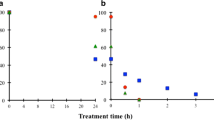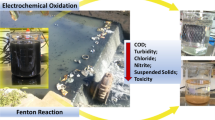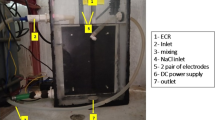Abstract
One of the most important wastewater treatment processes is microelectrolysis, which is extensively used in the primary treatment of pharmaceutical wastewater. In this study, microelectrolysis, as a pretreatment method for the refractory metronidazole pharmaceutical wastewater (MPW) of choice, was improved using the Fenton process and used to remove the chemical oxygen demand (COD) and improve the biochemical capability of MPW. The results showed that the highest COD removal of 40.8% was obtained in the presence of optimized significant factors and the BI (BI = biochemical oxygen demand over five days/COD) of MPW increased from 0.10 to 0.31. In addition, the ultraviolet–visible (UV–Vis) spectroscopy demonstrated that metronidazole in MPW was effectively removed during the combined processes. All these results showed that microelectrolysis combined with Fenton oxidation for MPW was an effective treatment process to achieve higher COD removal and biodegradability improvement. Finally, the breakthrough curves at different flow rates were measured to prove the feasibility of the combined process under optimal conditions.





Similar content being viewed by others
References
Aboudalle, A., Fourcade, F., Assadi, A. A., Domergue, L., Djelal, H., Lendormi, T., Taha, S., & Amrane, A. (2018). Reactive oxygen and iron species monitoring to investigate the electro-Fenton performances. Impact of the electrochemical process on the biodegradability of metronidazole and its by-products. Chemosphere, 199(MAY), 486–494.
Agarwal, S., Tyagi, I., & Gupta, V. K. (2017). Iron doped SnO2/Co3O4 nanocomposites synthesized by sol-gel and precipitation method for metronidazole antibiotic degradation. Materials Science and Engineering, 70(Pt 1), 178–183.
Biyela, P. T., Lin, J., & Bezuidenhout, C. C. (2004). The role of aquatic ecosystems as reservoirs of antibiotic resistant bacteria and antibiotic resistance genes. Water Science and Technology, 50(1), 45–50.
Bu, Q. W., Wang, B., Huang, J., Liu, K., Deng, S. B., Wang, Y. J., & Yu, G. (2016). Estimating the use of antibiotics for humans across China. Chemosphere, 144, 1384–1390.
Carrales, A. D. H., Ocampo, P. R., Leyva, R. R., & Rivera, U. (2014). Removal of the antibiotic metronidazole by adsorption on various carbon materials from aqueous phase. Chemosphere, 436, 276–285.
Carrales, A. D. H., Leyva, R. R., Martinez, C. J. I., & Ocampo, P. R. (2018). Competitive adsorption of dimetridazole and metronidazole antibiotics on carbon materials from aqueous solution. Water, Air, & Soil Pollution, 229(4), 108.1–108.15.
Checa, M., Figueredo, M., Aguinaco, A., & Beltrán, F. J. (2018). Graphene oxide/titania photocatalytic ozonation of primidone in a visible LED photoreactor. Journal of Hazardous Materials, 369, 70–78.
Chen, Q. L., An, X. L., Zheng, B. X., Gillings, M., & Zhu, Y. G. (2019). Loss of soil microbial diversity exacerbates spread of antibiotic resistance. Soil Ecology Letters, 1(1-2), 3–13.
Cheng, W., Yang, M., Xie, Y., Liang, B., Fang, Z., & Tsang, E. (2013). Enhancement of mineralization of metronidazole by the electro-Fenton process with a Ce/SnO2-Sb coated titanium anode. Chemical Engineering Journal, 220, 214–220.
Deng, Y. (2007). Physical and oxidative removal of organics during Fenton treatment of mature municipal landfill leachate. Journal of Hazardous Materials, 146(1-2), 334–340.
Dinda, G. B., Alkan, Y., Elebi, E. E., Tekba, M., Bekta, N., & Yatmaz, H. C. (2020). Treatment of pharmaceutical wastewater by combination of electrocoagulation, electro-Fenton and photocatalytic oxidation processes. Journal of Environmental Chemical Engineering. https://doi.org/10.1016/j.jece.2020.103777.
Dong, B. X., Pan, Y. M., Liu, W., & Teng, Y. L. (2018). An ultrastable luminescent metal–organic framework for selective sensing of nitroaromatic compounds and nitroimidazole-based drug molecules. Crystal Growth & Design, 18, 431–440.
Fan, L., Ni, J., Wu, Y., & Zhang, Y. (2009). Treatment of bromoamine acid wastewater using a combined process of micro-electrolysis and biological aerobic filter. Journal of Hazardous Materials, 162, 1204–1210.
Fang, Z. Q., Chen, J. H., Qiu, X. H., Qiu, X. Q., Wen, C., & Zhu, L. C. (2011). Effective removal of antibiotic metronidazole from water by nanoscale zero-valent iron particles. Desalination, 268, 60–67.
Farzadkia, M., Bazrafshan, E., Esrafili, A., Yang, J., & Shirzad-Siboni, M. (2015). Photocatalytic degradation of metronidazole with illuminated TiO2 nanoparticles. Journal of Environmental Health Science and Engineering, 13, 35–44.
Frank, U., Kleissle, E. M., Daschner, F. D., Leibovici, L., PauL, M., Andreassen, S., et al. (2006). Multicentre study of antimicrobial resistance and antibiotic consumption among 6780 patients with bloodstream infections. European Journal of Clinical Microbiology & Infectious Diseases, 25, 815–817.
Guo, L., He, K., Wu, S., Sun, H., Wang, Y., Huang, X., et al. (2016). Optimization of high-rate TN removal in a novel constructed wetland integrated with micro-electrolysis system treating high-strength digestate supernatant. Journal of Environmental Management, 178, 42–51.
Gürcü, B., Koca, Y. B., Ozkut, M., & Tuglu, M. I. (2016). Matrix changes due to the toxic effects of metronidazole in intestinal tissue of fish (Oncorhynchus mykiss). Chemosphere, 144, 1605–1610.
Hadden, D. J., Wells, K. L., Roberts, G. M., et al. (2011). Time resolved velocity map imaging of H-atom elimination from photoexcited imidazole and its methyl substituted derivatives. Physical Chemistry Chemical Physics, 13, 10342–10349.
Hama, A. K. H. (2019). Application of different advanced oxidation processes for the removal of chloroacetic acids using a planar falling film reactor. Chemosphere, 228, 377–383.
Hanna, N., Sun, P., Sun, Q., Li, X., Yang, X., Ji, X., et al. (2018). Presence of antibiotic residues in various environmental compartments of Shandong province in eastern China: its potential for resistance development and ecological and human risk. Environment International, 114, 131–142.
Ho, C., Sin, D. W. M., Wong, K. M., & Tang, H. P. O. (2004). Determination of dimetridazole and metronidazole in poultry and porcine tissues by gas chromatography–electron capture negative ionization mass spectrometry. Analytica Chimica Acta, 530, 23–31.
Hu, S., Wu, Y., Yao, H., Lu, C., & Zhang, C. (2016). Enhanced Fenton-like removal of nitrobenzene via internal micro-electrolysis in nano zerovalent iron/activated carbon composite. Water Science and Technology, 73, 153–160.
Hu, Z. F., Li, D. S., Deng, S. H., Liu, Y. H., Ma, C. Y., & Zhang, C. (2019). Combination with catalyzed Fe (0)-carbon microelectrolysis and activated carbon adsorption for advanced reclaimed water treatment: simultaneous nitrate and biorefractory organics removal. Environmental Science & Pollution Research, 26, 5693–5703.
Kermani, M., Asl, F. B., Farzadkia, M., Esrafili, A., Arian, S. S., Khazaei, M., et al. (2016). Heterogeneous catalytic ozonation by Nano-MgO is better than sole ozonation for metronidazole degradation, toxicity reduction, and biodegradability improvement. Densalination & Water Treatment, 57, 16435–16444.
Lan, S. H., Ju, F., & Wu, X. (2012). Treatment of wastewater containing EDTA-Cu (II) using the combined process of interior micro-electrolysis and Fenton oxidation–coagulation. Separation and Purification Technology, 89, 117–124.
Liu, L. H., Lin, Y., & He, Q. (2014). Pretreatment of lead 2, 4, 6-trinitroresorcinol wastewater by Fe-C internal electrolysis process. Advanced Materials Research, 7, 955–959.
Liu, P. P., Wang, Q. R., Zheng, C. L., & He, C. (2017). Sorption of sulfadiazine, norfloxacin, metronidazole, and tetracycline by granular activated carbon: kinetics, mechanisms, and isotherms. Water, Air, & Soil Pollution, 228(4), 129.1–129.14.
Löfmark, S., Edlund, C., & Nord, C. E. (2010). Metronidazole is still the drug of choice for treatment of anaerobic infections. Clinical Infectious Diseases, 50, S16–S23.
Neghi, N., & Mathava, K. (2017). Performance analysis of photolytic, photocatalytic, and adsorption systems in the degradation of metronidazole on the perspective of removal rate and energy consumption. Water, Air, & Soil Pollution, 228(9), 339.1–339.12.
Queiroz, A. C., Santos, J. D., & Monteiro, F. J. (2005). Development of a system to adsorb drugs onto calcium phosphate materials. Journal of Materials Science. Materials in Medicine, 16, 641–646.
Rana, R. S., Singh, P., Kandari, V., Singh, R., Dobhal, R., & Gupta, S. (2014). A review on characterization and bioremediation of pharmaceutical industries’ wastewater: an Indian perspective. Applied Water Science, 7(1), 641–646.
Saidi, I., Soutrel, I., Floner, D., Fourcade, F., Bellakhal, N., Amrane, A., et al. (2014). Indirect electroreduction as a pretreatment to enhance the biodegradability of metronidazole. Journal of Hazardous Materials, 278, 172–179.
Sánchez-Polo, M., Rivera-Utrilla, J., Prados-Joya, G., Ferro-Garcia, M. A., & Bautista-Toledo, I. (2008). Removal of pharmaceutical compounds, nitroimidazoles, from waters by using the ozone/carbon system. Water Research, 42, 4163–4171.
Sepehr, M. N., Al-Musawi, T. J., Ghahramani, E., Kazemian, H., & Zarrabi, M. (2016). Adsorption performance of magnesium/aluminum layered double hydroxide nanoparticles for metronidazole from aqueous solution. Arabian Journal of Chemistry, 10, 611–623.
Sharma, K., Talwar, S., Verma, A. K., Choudhury, D., & Mansouri, B. (2020). Innovative approach of in-situ fixed mode dual effect (photo-Fenton and photocatalysis) for ofloxacin degradation. Korean Journal of Chemical Engineering, 37(2), 350–357.
Shemer, H., Kunukcu, Y. K., & Linden, K. G. (2006). Degradation of the pharmaceutical metronidazole via UV, Fenton and photo-Fenton processes. Chemosphere, 63(2), 269–276.
Tong, L., Pérez, S., Gonçalves, C., Alpendurada, F., Wang, Y., & Barceló, D. (2011). Kinetic and mechanistic studies of the photolysis of metronidazole in simulated aqueous environmental matrices using a mass spectrometric approach. Analytical and Bioanalytical Chemistry, 399, 421–428.
Wang, L. Q., Yang, Q., Wang, D. B., Li, X., Zeng, G., Li, Z., et al. (2016). Advanced landfill leachate treatment using iron-carbon micro-electrolysis Fenton process: process optimization and column experiments. Journal of Hazardous Materials, 318, 460–467.
White, D., Lapworth, D. J., Civil, W., & Wiliams, P. (2019). Tracking changes in the occurrence and source of pharmaceuticals within the River Thames, UK; from source to sea. Environmental Pollution, 249(JUN.), 257–266.
Xia, Y., Zhang, Q., Li, G., Tu, X. B., Zhou, Y. Q. H., & X. H. (2019). Biodegradability enhancement of real antibiotic metronidazole wastewater by a modified electrochemical Fenton. Journal of the Taiwan Institute of Chemical Engineers, 2, 256–263.
Xu, X., Cheng, Y., Zhang, T., Ji, F., & Xu, X. (2016). Treatment of pharmaceutical wastewater using interior micro-electrolysis/Fenton oxidation-coagulation and biological degradation. Chemosphere, 152, 23–30.
Yang, X. Y. (2009). Interior micro-electrolysis oxidation of polyester wastewater and its treatment technology. Journal of Hazardous Materials, 169, 480–485.
Zhou, X., Qiao, M., Su, J. Q., & Zhu, Y. G. (2019). High-throughput characterization of antibiotic resistome in soil amended with commercial organic fertilizers. Journal of Soils and Sediments, 19(2), 641–651.
Zrncevic, S. (2016). Pharmaceuticals and methods of treating wastewater from pharmaceutical industry. Hrvatske Vode, 24(96), 119–136.
Acknowledgments
This research was financially supported by the project of Beijing Natural Science Foundation (No. 7191008) and National Natural Science Foundation of China (No. 11675098).
Author information
Authors and Affiliations
Corresponding authors
Additional information
Publisher’s Note
Springer Nature remains neutral with regard to jurisdictional claims in published maps and institutional affiliations.
Rights and permissions
About this article
Cite this article
Xiao, Y., Shao, Y., Luo, M. et al. Optimized Study and Column Experiments on Treatment Process of Metronidazole Pharmaceutical Wastewater by Microelectrolysis and Fenton Oxidation. Water Air Soil Pollut 232, 182 (2021). https://doi.org/10.1007/s11270-021-05117-z
Received:
Accepted:
Published:
DOI: https://doi.org/10.1007/s11270-021-05117-z




